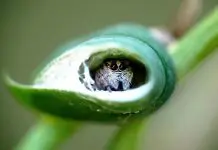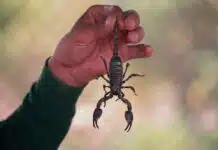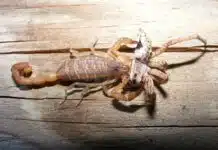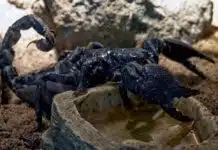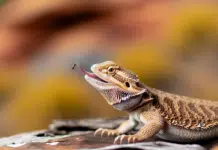So, you want to find out how to tell what gender a bearded dragon is? Finding out your bearded dragon’s gender may seem a bit complicated at first, but it just takes a little information and practice.
Luckily, there are three ways to determine the bearded dragon gender.
The first way is the most accurate way. And that is to look for hemipenal bulges. Which is located near the base of your bearded dragon’s tail. You need to look for a distinctive body shape on your bearded dragon’s underside.
If you need to confirm the sex of your bearded dragon, you can literally use a flashlight to shine some light on the issue.
Finding femoral pores is the 2nd good method to determine the sex of your bearded dragon.
Femoral pores are a line of little hole-like structures that are very visible in male bearded dragons. They are far less prominent in female beardies and may hardly be detectable at all.
Finally, since you want to know how to tell the gender of a bearded dragon, it’s helpful to look for additional physical traits. Head size or head width can help you figure out if your beardie is male or female.
This method isn’t very accurate, but it can provide helpful confirmation if you’re not 100% sure about the sex of your bearded dragon.
By using one or more of the easy methods below, you’ll have a good idea of how to tell your bearded dragon’s gender. (After that, throwing a gender reveal party for your beardie is up to you.)
More seriously, knowing the gender of your bearded dragon will help you provide the best possible care throughout all stages of its life.
Look for Hemipenal Bulges
What are hemipenal bulges?
The term “hemipenal bulges” sounds a lot more complicated than it actually is. The best way to find out is to get to know your bearded dragon’s anatomy a little better.
First, take your bearded dragon and gently turn it over to expose its belly. You are going to be looking right where your beardie’s tail joins with its body.
Make sure you can see the tail area. Be careful not to crank the tail over the bearded dragon’s back because it can break and hurt your dragon. Unlike many breeds of lizard, bearded dragons cannot grow back their tails.
Near the base of your beardie’s tail, you will see a sideways slit called the “vent.” Although humans and most mammals have separate exits for reproduction, urination, and fecal matter, bearded dragons have just one.
The vent is essentially the “exit door” for the cloaca, a kind of one-stop shop for the products of the bladder, colon, and reproductive system.
Looking near the vent, you may be able to see two long, fingerlike shapes on either side of your bearded dragon’s tail right below the vent.
Those two shapes are the hemipenal bulges. They will look as if two very small fingers were embedded underneath your bearded dragon’s tail skin. Generally, there will be a little dimple between the two long bulges.
The general shape and placement of the hemipenal bulges might remind you of bunny ears.
If your beardie has these two long hemipenal bulges, it is probably male. Your female beardie will also have a bulge below her vent.
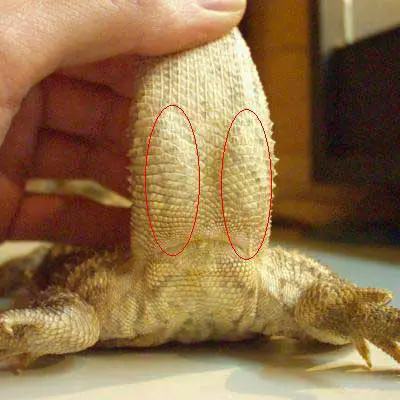
Hers will be one single bulge located right in the middle of the tail, not two long bulges on either side. A female dragon’s bulge will be softly triangular and broad and may look a little like George Washington’s hat.
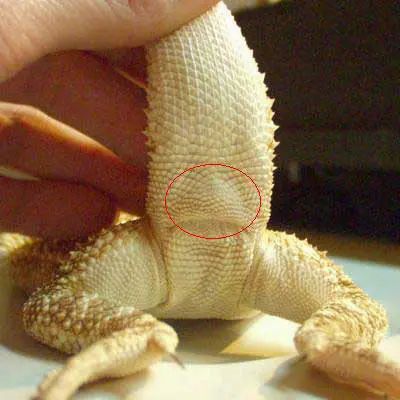
How can I use a flashlight to tell the sex of my bearded dragon?
When they are young, all bearded dragons appear to be female. If you’re wondering how to tell the gender of a baby bearded dragon, it’s almost impossible on your own.
It’s only when beardies reach their sexual maturity between 8-12 months that most people can detect sexual differences.
When your dragon has reached that age, you can use a flashlight if you’re wondering, “How do you tell a bearded dragon’s gender?”
To use the flashlight method, gently lift your bearded dragon’s tail. Never lift it more than ninety degrees or bend it back along your beardie’s spine.
That will hurt and you may break your beardie’s tail. Turn off the lights in the room and shine a flashlight through the tail area near the vent.
If your beardie is male, you will see the shadow of its testes. The general shape of the shadow will look like two long prongs on either side of the tail.

It may remind some people of the horn sign heavy metal players make with their fingers. If your beardie is female, you might see a darker shadow, but it’s less defined.
It may look like a small black blob or like a silhouette of the shrug emoji.
Look for Femoral Pores
What are femoral pores?
If you take your bearded dragon and gently turn him or her belly-up, you may be able to see a body feature called femoral pores. Femoral pores are a series of little holes or pores tha run along your male bearded dragon’s inner thighs.
Femoral pores form a line beginning from your bearded dragon’s knees and continuing up both inner thighs and vent. The line of pores follow their “inseam area.” Your bearded dragon may have ten or more pores. They can look like pinpricks or small pits along the inner leg.
If you want to know how to tell a bearded dragon’s gender, these femoral pores can be very helpful. Sexually mature male bearded dragons usually have visible femoral pores, but female bearded dragons do not.
What does my bearded dragon use femoral pores for?
A femoral pore is an example of an exocrine gland. Exocrine glands excrete substances from the body onto the outside of the skin or other objects. In bearded dragons, the femoral pores contain a waxy substance that the bearded dragon uses to mark his territory and attract mates.
Beginning beardie fans might think that the femoral pores are blackheads, but they’re not. Although they’re waxy and porous, the femoral pores serve an important purpose. The waxy substance contains pheromones that allow the male dragon to attract a female dragon during their mating season. The secretion also absorbs UV light, so any animal that can detect UV light can see where the bearded dragon has marked his territory.
As you can see, femoral pores are very important, and they tend to be a clear physical difference between male and female bearded dragons.
Why are my bearded dragon’s femoral pores so large?
Sometimes, your bearded dragon’s femoral pores might appear to be enlarged. If you look along the line of the femoral pores, it might look as if they have little horns or protrusions stuck in them like corks in a wine bottle.
It’s natural to wonder if big pores are normal for your bearded dragon. You may wonder if your beardie’s femoral pores are plugged up or impacted. The good news is that this is perfectly normal. What’s important to know is that in mating season, your bearded dragon is trying to put the word out that he wants a mate. Larger femoral pores are normal at this time.
Unless your bearded dragon’s femoral pores are swollen, red, or sore, there is usually no need for worry. Leave your dragon’s femoral pores alone. If you do have further concerns, you might want see a veterinarian who specializes in exotic animals and reptiles. It’s important to provide the best care for your bearded dragon and talk with a vet who will answer your questions.
Look at other physical traits
What methods to determine gender should I not use?
If you want to know how to tell the gender of a juvenile bearded dragon, it’s not always easy. The question of “bearded dragon boy or girl” has been brought up many times, and not all of the advice out there is accurate.
Here are some methods that aren’t very accurate to determine the sex of your bearded dragon.
Do females turn their beards black?
Bearded dragons are called “bearded” because below their jaws is a fleshy sac that they can puff out when they’re angry or excited. Males can develop a larger black beard, but this isn’t a very accurate method of sexing your dragon. For one, if you have one bearded dragon, it’s hard to compare the blackness of your dragon’s beard with anything else. Next, it isn’t always the case that males are the only ones with large black beards.
Beards are useful tools for finding a new partner or for showing dominance or territoriality. When bearded dragons feel agitated, they’ll puff out their beards and turn them black. However, this not an accurate method to determine gender. Males will reveal their beards as a courtship gesture, and females will use them to frighten away a threat.
However, it’s not always easy to determine what’s going on in a particular moment. Is your beardie trying to make a love connection or swiping left on a potential mate she does not want?
Male is larger than females
Bearded dragon males tend to be bigger than females, but this is not always a reliable indicator. It’s hard to compare sizes if you have one dragon. Furthermore, bearded dragons are similar to carp or koi: They will only get as large as their environment allows them.
If you’ve raised multiple bearded dragons in an optimal environment with plenty of habitat space, you increase the chances that your dragon will achieve its full size. However, if you are a new beardie owner and you buy an adult bearded dragon, you don’t always know the details of its environment. If a juvenile dragon grew up in a habitat that was too small, they may never achieve their full length.
Furthermore, incorrect feeding may limit bearded dragon length. Your beardies need a full range of vitamins (especially iron, D3, and calcium). They also need vegetables, plants, fruits, and insects to achieve maximum adult growth. An adult bearded dragon that hasn’t eaten a balanced diet may not achieve their full growth potential.
As you can see, it’s not easy to put two beardies next to each other and know for sure that the larger one is the male. It’s possible, but it’s not always the case. Given the variables in breeding, correct nutrition, and environment, this is not a very accurate method to use.
Bearded dragons waving their arms
Bearded dragons of both genders wave their arms. We’re not entirely sure why they do this, but the leading theory is that it’s a form of communication. Some bearded dragon experts argue that arm-waving is a form of submission, especially to a powerful or dominant beardie. However, it could simply be a form of recognition or the bearded dragon equivalent of waving hello.
What’s a more accurate quick method?
A more accurate method of determining the sex of your bearded dragon is to look at the width of its head. Like many other methods, this is harder to determine if you have only one bearded dragon.
However, if you know your bearded dragon’s age, this test becomes a little more accurate. If you have that information, you can compare the width of your beardie’s head to the width of others the same age and do some quick figuring. Males generally have wider heads than females do.
Conclusion
The bottom line is that determining the gender of your bearded dragon may take a little time and some study. With enough information, you should be able to arrive at a solid conclusion.
Remember to look first for hemipenal bulges and shine a light through your beardie’s tail to look for the shadow of its testes. It’s important to be gentle during this process and not lift your bearded dragon’s tail above 90 degrees.
While you’re looking, check to see if you can find a row of femoral pores along the inside of your dragon’s thighs. They should look like a row of little pinpricks or holes.
Last but not least, compare the width of your bearded dragon’s head to others of the same age. You may want to take note of your beardie’s arm-waving or length just in case, but be sure to understand that the other methods are more reliable.
With all of these clues in hand, you should be able to have a pretty good guess as to your bearded dragon’s gender. If you have any great ideas, stories, or questions, feel free to share and comment!
Watch the video below to understand better



![Sick Axolotl, Fungus, Stress Symptoms [Axolotl Illness Guide 2025] Axolotl fungus](https://exopetguides.com/wp-content/uploads/2018/06/axolotl-218x150.jpg.webp)

